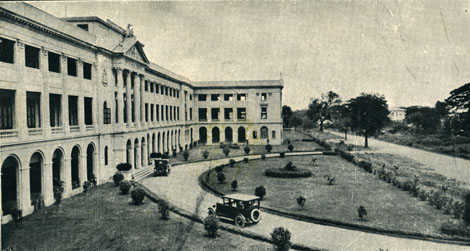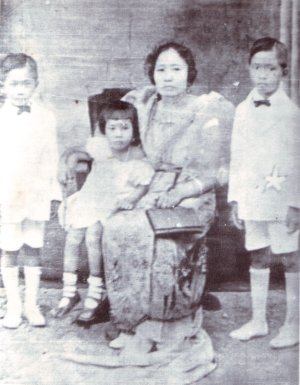|
Malate, Manila
Malate is a district of Manila, Philippines. Together with the district of Ermita, Manila, Ermita, it serves as Manila's center for commerce and tourism. Etymology The name ''Malate'' is derived from a corruption of the Tagalog language, Tagalog word ''maalat'' ("salty"). The name likely referred to the brackish waters, where the river estuary (in today's Malate Estero) meets the bay. Antonio de Morga, writing in his 1609 ''Sucesos de las Islas Filipinas'': "Manila has two drives for recreation. One is by land, along the point called Nuestra Señora de Guia. It extends for about a legua along the shore and is very clean and level. Thence it passes through a native street and settlement, called Bagunbayan, to a chapel, much frequented by the devout, called Nuestra Señora de Guia, and continues for a goodly distance further to a monastery and mission-house of the Augustinians, called Mahalat." José Rizal, who republished Morga's account, later annotated: "Better, Maalat. The S ... [...More Info...] [...Related Items...] OR: [Wikipedia] [Google] [Baidu] |
Manila
Manila, officially the City of Manila, is the Capital of the Philippines, capital and second-most populous city of the Philippines after Quezon City, with a population of 1,846,513 people in 2020. Located on the eastern shore of Manila Bay on the island of Luzon, it is classified as a Cities of the Philippines#Independent cities, highly urbanized city. With , Manila is one of the world's List of cities proper by population density, most densely populated cities proper. Manila was the first chartered city in the country, designated bPhilippine Commission Act No. 183on July 31, 1901. It became autonomous with the passage of Republic Act No. 409, "The Revised Charter of the City of Manila", on June 18, 1949. Manila is considered to be part of the world's original set of global cities because its commercial networks were the first to extend across the Pacific Ocean and connect Asia with the Hispanic America, Spanish Americas through the Manila galleon, galleon trade. This marked t ... [...More Info...] [...Related Items...] OR: [Wikipedia] [Google] [Baidu] |
Paco, Manila
Paco, formerly known as Dilao, is a district of Manila, Philippines, located south of the Pasig River and San Miguel, west of Santa Ana, southwest of Pandacan, north of Malate, northwest of San Andres Bukid, and east of Ermita. It had a population of 79,839 people as of the 2020 census. History Paco was known as Dilao because of the Amaryllis plants that were once plentiful in this district. Dilao or ''dilaw'' is a Tagalog word for the color yellow. Although, some sources say, it was named Dilao or "Yellow Plaza" by the Spanish settlers because of the Japanese migrants who lived there, describing their physiognomy. Spanish Franciscan missionaries founded the town of Paco as early as 1580. It was a town part of the province of Tondo, which was later renamed Manila in 1859, until 1901. The Japanese established an enclave quite early or Nihonmachi in Dilao where they numbered between 300 and 400 in 1593. A statue of Takayama can be found there. In 1603, during the Sang ... [...More Info...] [...Related Items...] OR: [Wikipedia] [Google] [Baidu] |
LRT Line 1 (Metro Manila)
The Light Rail Transit Line 1, commonly referred to as LRT Line 1 or LRT-1, is a state-owned (through Light Rail Transit Authority (LRTA)) but privately operated (by Light Rail Manila Corporation (LRMC)) light rapid transit system line in Metro Manila, Philippines, and as part of the Manila Light Rail Transit System. Originally referred to as Metrorail and the Yellow Line, LRT Line 1 was reclassified to be the Green Line in 2012. It travels in a general north–south direction from Dr. Santos station, Dr. Santos to , and then east–west from Monumento to Roosevelt station (LRT), Fernando Poe Jr. Currently, the line consists of 25 stations and runs on of fully elevated route. Although it has the characteristics of light rail, such as with the type of rolling stock used, it is more akin to a rapid transit system owing to its total grade separation and high passenger throughput. First envisioned in a 1977 study conducted by Hyder Consulting, Freeman Fox and Associates which sugg ... [...More Info...] [...Related Items...] OR: [Wikipedia] [Google] [Baidu] |
Taft Avenue
Taft Avenue (; ) is a major road in southern Metro Manila. It passes through three cities in the metropolis: Manila, Pasay, and Parañaque. The road was named after the former Governor-General of the Philippines and President of the United States, U.S. President William Howard Taft; the Philippines was a former Commonwealth (U.S. insular area), commonwealth territory of the United States in the first half of the 20th century. The avenue is a component of National Route 170 (N170), a secondary road in the Philippine highway network and Radial Road 2 (R-2) of the List of roads in Metro Manila, Manila arterial road network. Route description From the north, Taft Avenue starts as an eight-lane avenue, with four lanes per direction, at the Lagusnilad vehicular underpass at its intersection with Padre Burgos Avenue in Ermita, Manila, Ermita. It then crosses Ayala Boulevard and Finance Street and forms the eastern edge of Rizal Park up to Kalaw Avenue. It then crosses United Nations A ... [...More Info...] [...Related Items...] OR: [Wikipedia] [Google] [Baidu] |
Quirino Avenue
President Elpidio Quirino Avenue, more commonly known as Quirino Avenue, is a 6-10 lane divided highway in Manila, Philippines. It runs for in a northeast–southwest direction from Nagtahan Bridge (now Mabini Bridge) across Santa Mesa, Manila, Santa Mesa in the north to Roxas Boulevard in Malate, Manila, Malate in the south. It passes through the Paco, Manila, Paco and Pandacan, Manila, Pandacan districts and serves as a truck route between the Port Area, Manila, Port Area and the South Luzon Expressway. North of Nagtahan Bridge, the road continues as Nagtahan Street. It is designated as part of Circumferential Road 2. It is named after Elpidio Quirino, the sixth President of the Philippines. Route description ;Nagtahan Bridge to Paco-Santa Mesa Road section The northern end of Quirino Avenue is at the intersection of Paz Mendoza Guazon (Otis) and Jesus Streets in Paco, at the foot of the Mabini Bridge, Nagtahan Bridge, as a continuation of Nagtahan Street. Heading south, ... [...More Info...] [...Related Items...] OR: [Wikipedia] [Google] [Baidu] |
Roxas Boulevard
Roxas Boulevard is a popular waterfront promenade in Metro Manila in the Philippines. The boulevard, which runs along the shores of Manila Bay, is well known for its sunsets and stretch of coconut trees. The divided roadway has become a trademark of Philippine tourism, famed for its yacht club, hotels, restaurants, commercial buildings and parks. The boulevard was completed in the 1910s. Originally called ''Cavite Boulevard'', it was renamed ''Dewey Boulevard'' in honor of the American admiral George Dewey, whose forces defeated the Spanish navy in the Battle of Manila Bay in 1898, ''Heiwa Boulevard'' in late 1941 during the Japanese occupation, and finally Roxas Boulevard in 1963 in honor of Manuel Roxas, the fifth president of the Philippines. It was also designated as a new alignment of the Manila South Road that connects Manila to the southern provinces of Luzon. The boulevard is also an eight-lane major arterial road in Metro Manila designated as Radial Road 1 (R-1) ... [...More Info...] [...Related Items...] OR: [Wikipedia] [Google] [Baidu] |
Bulong (film)
''Bulong'' () is a 2011 Filipino comedy horror film directed by Chito S. Roño, who co-wrote the original story with Roy Iglesias. Starring Angelica Panganiban and Vhong Navarro on their first film as the lead stars, the film revolves around a brokenhearted nurse who seeks help from the deceased to find a girlfriend he wanted. It also stars Angie Ferro, Bangs Garcia, Sylvia Sanchez, and Jon Avila. Produced and released by Star Cinema, the film was theatrically released on February 2, 2011. Plot Conan, a nurse, wants to gain the heart of his colleague Ellen and asks his friend on how to achieve his wish. His friend tells him of a legend that says that if one whispers his/her wish to a dead body, the soul of the deceased will help them. He then seeks the help of his other friend Oprah, who is a niece of a soothsayer. He whispers to a corpse his wish that Ellen would fall in love with him, but finds out that the deceased went deaf before it expired. Conan goes home in disappoin ... [...More Info...] [...Related Items...] OR: [Wikipedia] [Google] [Baidu] |
Cinco (film)
''Cinco'' () is a 2010 Filipino horror anthology film produced and released by Star Cinema. The film consists of five different horror stories which each featuring an ensemble cast including Sam Concepcion, AJ Perez, Robi Domingo, Jodi Sta. Maria, Maja Salvador, Rayver Cruz, Mariel Rodriguez, Pokwang and Zanjoe Marudo and are directed by Frasco Mortiz, Enrico C. Santos, Ato Bautista, Nick Olanka, and Cathy Garcia-Molina. The film was released on July 14, 2010. Plot The film is divided into five parts entitled "Braso" (), "Paa" (), "Mata" (), "Mukha" (), and "Puso" (), which all revolve around a hand with an "R.I.P." tattoo. One: Braso (Arm) Three neophytes are brought to a morgue while dressed in lingerie for the final part of their initiation to join a fraternity. After snooping around the place, the boys find a detached arm with an "R.I.P." tattoo of a corpse and it comes to life, much to their terror. The animated hand causes trouble to the group before they escape. Soon a ... [...More Info...] [...Related Items...] OR: [Wikipedia] [Google] [Baidu] |
Ferdinand Marcos
Ferdinand Emmanuel Edralin Marcos Sr. (September 11, 1917 – September 28, 1989) was a Filipino lawyer, politician, dictator, and Kleptocracy, kleptocrat who served as the tenth president of the Philippines from 1965 to 1986. He ruled the country under Martial law under Ferdinand Marcos, martial law from 1972 to 1981, granting himself expanded powers under the Constitution of the Philippines#The 1973 Constitution, 1973 Constitution. Marcos described his philosophy as "constitutional authoritarianism". He was deposed in 1986 by the People Power Revolution and was succeeded as president by Corazon Aquino. Marcos gained political success by exaggerating his actions in World War II, claiming to have been the "most decorated war hero in the Philippines". — United States Army documents described his claims as "fraudulent" and "absurd". After the war, he became a lawyer. He served in the Philippine House of Representatives from 1949 to 1959 and the Philippine Senate from 1959 to ... [...More Info...] [...Related Items...] OR: [Wikipedia] [Google] [Baidu] |
World War II
World War II or the Second World War (1 September 1939 – 2 September 1945) was a World war, global conflict between two coalitions: the Allies of World War II, Allies and the Axis powers. World War II by country, Nearly all of the world's countries participated, with many nations mobilising all resources in pursuit of total war. Tanks in World War II, Tanks and Air warfare of World War II, aircraft played major roles, enabling the strategic bombing of cities and delivery of the Atomic bombings of Hiroshima and Nagasaki, first and only nuclear weapons ever used in war. World War II is the List of wars by death toll, deadliest conflict in history, causing World War II casualties, the death of 70 to 85 million people, more than half of whom were civilians. Millions died in genocides, including the Holocaust, and by massacres, starvation, and disease. After the Allied victory, Allied-occupied Germany, Germany, Allied-occupied Austria, Austria, Occupation of Japan, Japan, a ... [...More Info...] [...Related Items...] OR: [Wikipedia] [Google] [Baidu] |
Mestizo
( , ; fem. , literally 'mixed person') is a term primarily used to denote people of mixed European and Indigenous ancestry in the former Spanish Empire. In certain regions such as Latin America, it may also refer to people who are culturally European even though their ancestors were Indigenous American or Austronesian. The term was used as an ethno-racial exonym for mixed-race that evolved during the Spanish Empire. It was a formal label for individuals in official documents, such as censuses, parish registers, Inquisition trials, and others. Priests and royal officials might have classified persons as mestizos, but individuals also used the term in self-identification. With the Bourbon reforms and the independence of the Americas, the caste system disappeared and terms like "mestizo" fell in popularity. The noun , derived from the adjective , is a term for racial mixing that did not come into usage until the 20th century; it was not a colonial-era term.Rappaport, Joa ... [...More Info...] [...Related Items...] OR: [Wikipedia] [Google] [Baidu] |
Spanish–American War
The Spanish–American War (April 21 – August 13, 1898) was fought between Restoration (Spain), Spain and the United States in 1898. It began with the sinking of the USS Maine (1889), USS ''Maine'' in Havana Harbor in Cuba, and resulted in the U.S. acquiring sovereignty over Puerto Rico, Guam, and the Philippines, and establishing a protectorate over Cuba. It represented U.S. intervention in the Cuban War of Independence and Philippine Revolution, with the latter later leading to the Philippine–American War. The Spanish–American War brought an end to almost four centuries of Spanish presence in the Americas, Asia, and the Pacific; the United States meanwhile not only became a major world power, but also gained several island possessions spanning the globe, which provoked rancorous debate over the wisdom of expansionism. The 19th century represented a clear decline for the Spanish Empire, while the United States went from a newly founded country to a rising power. In 1895, C ... [...More Info...] [...Related Items...] OR: [Wikipedia] [Google] [Baidu] |







